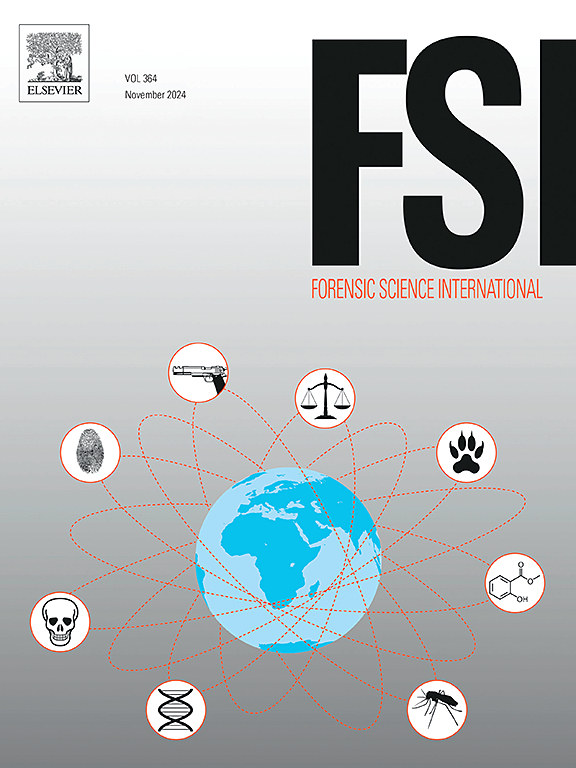使用迁移学习和预先训练的深度神经网络进行尖锐损伤识别的可解释人工智能
IF 2.2
3区 医学
Q1 MEDICINE, LEGAL
引用次数: 0
摘要
目的探讨一种基于人工智能的深度学习模型自动识别和分类尖锐伤的方法,评估其有效性(如准确性和可解释性),并为法医损伤分类提供支持。方法收集杀人案中刀伤(723张)、砍伤(314张)、割伤(124张)照片,共1161张。经过预处理和加权随机抽样,将处理后的数据集按8:2的比例划分为训练集和验证集。此外,来自代表三种类型伤口的新病例的212张图像被收集为人类与人工智能测试的外部数据集。具体来说,在自然图像上预训练的三个分类网络——resnet50、GoogLeNet和shufflenet - v2——通过训练集上的迁移学习进行微调。然后对模型进行了精度、召回率、F1分数和阅读时间方面的定量测试。人工智能模型的测试结果与法医病理学家使用外部测试数据进行比较。此外,我们根据类激活映射技术生成的显著性图,分析了这些模型捕获的图像解释因素。结果3种模型均成功对3种伤口进行了分类。其中,GoogLeNet网络模型的总体分类准确率(total)和召回率为88.2% %。其中,刀伤分类准确率最高,为98.4% %,刀伤分类准确率次之,为96.7 %,刀伤分类准确率最低,为30.0 %。分类准确率与样本量呈正相关。该模型的最大准确率为88.4 %,F1分数为0.860,每张图像的分类时间为0.04 秒。与法医病理学家比较发现,该模型的分类时间较短,对刀伤和砍伤的准确率与高级法医病理学家相当,但对割伤的准确率低于初级法医病理学家。人工智能模型捕获的图像解释因素与法医病理学家确定的特征伤口位置密切相关。结论该模型能有效识别刀伤和砍伤的图像特征,实现准确识别和快速区分。人工智能对刀刺和刀砍的分类性能与高级法医病理学家相当,表明该模型具有实用价值。本文章由计算机程序翻译,如有差异,请以英文原文为准。
Explainable AI for sharp injury identification using transfer learning with pre-trained deep neural networks
Objective
To investigate an AI-based method for automatically identifying and classifying sharp injuries using deep learning models, evaluate its effectiveness (e.g., accuracy and explainability), and support forensic injury classification.
Methods
A dataset comprising 1161 photos was collected, including stab wounds (723), chop wounds (314), and slash wounds (124) from homicide cases. After preprocessing and weighted random sampling, the processed dataset was divided into training and validation sets in an 8:2 ratio. Additionally, 212 images from new cases representing the three types of wounds were collected as an external dataset for a human vs. AI test. Specifically, three classification networks pre-trained on natural images—ResNet50, GoogLeNet, and ShuffleNet-V2—were fine-tuned via transfer learning on the training set. The models were then quantitatively tested in terms of precision, recall, F1 score, and reading time. The test results of AI models were compared with forensic pathologists using the external test data. Moreover, we analyzed the image explanation factors captured by these models according to the saliency maps produced by the class activation mapping techniques.
Results
All three models successfully classified three types of wounds. Among these, the GoogLeNet network model demonstrated an overall classification accuracy (total) and recall rate of 88.2 %. The model achieved its highest classification accuracy of 98.4 % for stab wounds, followed by 96.7 % for chop wounds and 30.0 % for slash wounds, the lowest among them. Classification accuracy is positively correlated with sample size. The model achieved a maximum precision rate of 88.4 % and a F1 score of 0.860, with a classification time of 0.04 seconds per image. A comparison with forensic pathologists revealed that the model's classification time was shorter, while its accuracy of stab and chop wounds was comparable to that of senior forensic pathologists, but the accuracy for slash wound was lower than that of junior forensic pathologists. The image explanation factors captured by AI models align closely with the characteristic wound positions identified by forensic pathologists.
Conclusion
The AI model effectively identifies the image characteristics of stab and chop wounds, enabling accurate recognition and rapid differentiation. The AI classification performance for stab and chop was comparable to that of senior forensic pathologists, implying the model’s practical utility.
求助全文
通过发布文献求助,成功后即可免费获取论文全文。
去求助
来源期刊

Forensic science international
医学-医学:法
CiteScore
5.00
自引率
9.10%
发文量
285
审稿时长
49 days
期刊介绍:
Forensic Science International is the flagship journal in the prestigious Forensic Science International family, publishing the most innovative, cutting-edge, and influential contributions across the forensic sciences. Fields include: forensic pathology and histochemistry, chemistry, biochemistry and toxicology, biology, serology, odontology, psychiatry, anthropology, digital forensics, the physical sciences, firearms, and document examination, as well as investigations of value to public health in its broadest sense, and the important marginal area where science and medicine interact with the law.
The journal publishes:
Case Reports
Commentaries
Letters to the Editor
Original Research Papers (Regular Papers)
Rapid Communications
Review Articles
Technical Notes.
 求助内容:
求助内容: 应助结果提醒方式:
应助结果提醒方式:


